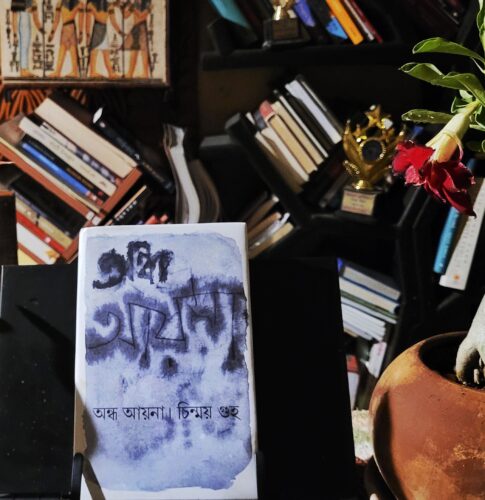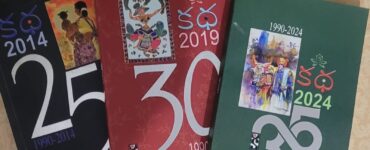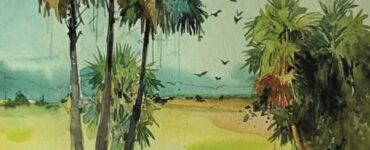What a coincidence!
A lone man is standing still over the little bridge which is adjoint to the famous Cathèdrale Notre-Dame de Paris. He is literally stunned looking at the Gothic sculptures of the Notre-Dame. He is visualizing an extremely handsome manly figure, Victor Hugo busy in writing his famous Classic ‘Hunchback of Notre-Dame’ in his absolute consciousness.
The man is standing beside the river Seine, the famous river in Paris. As if he himself experienced the river of love in his subconscious mind, he is encountering the shadowy figures of James Joyce, Eliot, Earnest Hemingway, Ezra Pound.
During his stay in Paris, the man is in the search of the classic beauty of river Seine, beside which the famous English bookstore ‘ Shakespeare & Co. ‘ is situated. As if he is seeing all the shadowy figures of Joyce, Pound, Eliot, Hemingway have arrived and met in the bookstore.
Imaginary monologue between a Teacher and a Student
In another scene, a student is looking towards the nature and thinking about one of the greatest philosophers, Baruch de Spinoza, to whom Frederick Nietzsche did fear his dangerous proximity to his own ‘will power’— a concept he claims as his own original philosophical creation (“I have a precursor, and what a precursor!”).
When the Teacher asked the student, pointing a tree while cleansing his glasses, a cluster of tears like raindrops dripped from his eyes.
‘A cluster of tears like raindrops ‘.. The very expressive scene manifested in front of the readers and here lies the beauty of the non-fiction ‘ Andha Ayna’, the stupendous non-fiction written by Emeritus Professor of Calcutta University, Chinmoy Guha.
Professor Guha’s brilliant insightful style of writing unveils slowly the scene where he himself is the student who gets confused, bewildered with a tree, named Nagmandal. The Teacher asked the student about the tree, named Golden Rain Tree, in bengali which is famous in the land of Tagore as ‘Amaltas’ , once he showed to his student.
Though imaginary yet a pensive serenity spread through the conversation between the Teacher and the Student goes on from where we, the readers came to know about their keen observation to the nature’s bountiful supply of freshness. They both are engaged in deep solicitude and observances of different trees, named ‘Manjiri’ , ‘Parash Pipul’ and ‘Sultan Champa’. How unique and beautiful the names of the trees we got to learn from their conversations. And the teacher merged in a star, maybe it’s Revati, or Mrigashira or perhaps in Rohini in a blink of the eye.
The student is standing still under the vast, eternal ever continuing nature which is merged into the infinity. The whole non-fiction gradually moves in the search of a void, an eternal continuation. He imagines if this nature has emerged from the ribs of Shakespeare and Spinoza where they’re standing like astonishing tree- lamps.
The student goes on imagining, his pen goes on creating the extraordinary imaginary ambience where he is roaming under the vastness of nature.
In his imaginary vision, he is visualizing a woman who told him that it’s possible to match Shakespeare and Spinoza together, the woman whose name was perhaps Rosalind or might be Viola!
By his utterly astonishment, the Essayist/ non-fiction writer Professor Chinmoy Guha asked the imaginary woman if she is the creation of Shakespeare himself! How did she able to match two world’s greatest thinkers if she wouldn’t be the creation of them? Did they provide the life’s lost seeds on her blue palms?
Ahh! at last she replied:
‘A primrose by a river’s brim
A yellow primrose was to him
And it was nothing more’.
Here lies the excellence of Professor Guha’s iconic way of thinking to delve deep in the world literature. Though she replied, she mentioned the lines from Wordsworth’s famous poem ‘ Peter Bell’ !
Why she mentioned the lines of Wordsworth’s legendary poem’?
Let’s have a check. As a perfect poet of nature, she considers that it wasn’t the poet’s duty to be ‘ A guide of knowledge, neither it’s his duty to introduce even knowledge of Nature. He should only guide us to the immeasurable joy, which co – exists with the greatest knowledge, or it may be denied to the greatest knowledge, or may co- exist with the greatest ignorance or to be denied too.
The woman uttered only three lines:
in which she wanted to convey that alike Wordsworth; she doesn’t take any pleasure in it rather in something more which the eyes fail to see.
It doesn’t matter whose eyes it may be a poet’s, a farmer’s or a a scientist’s which only poetry may be able to provide us. The finest spirit of knowledge that automatically brings us abundance of joy.
This is ‘something more’ ‘ something over and above the level which our mortal eyes want to see.
She even said against the writer’s mention of Shakespeare’s lines -‘ A fool! A fool! I met a fool in the forest’.
He wanted to say the woman that while discussing about Shakespeare and Spinoza, she suddenly brought the reference of Wordsworth’s lines beyond the writer’s knowledge.
But the woman again simply mentioned a dialogue from ‘Shakespeare’s Henry the Fourth, Part 1, Act – 3, which is quite remarkable.
” Diseased nature oftentimes breaks forth
In strange eruptions’
With this single dialogue she conveyed her message that sickening nature often brings earthquakes, calamities.
Often fertile earth is affected also and irritated by pain as she shelters uncomfortable winds and storms within her. With these strange eruptions, even the fertile earth oftentimes gets sick. It’s not that the Mother Earth doesn’t face calamities and eruptions. So, nothing there to perceive only her beauteous glory.
How the non- fiction keeps the pace by balancing the great philosopher Spinoza with world famous playwright Shakespeare and another world-class poet Wordsworth in the same domain. The magical hypnotism of Professor Guha’s profundity and his depth of knowledge on World Literature manifested as brightening as broad daylight.
Again, he compares the woman with Bengal’s Surrealistic poet Jibanananda Das’s Dream woman ‘Banalata Sen.’ This imaginary woman ain’t as naive as the woman like Sen– his spontaneous acknowledgement. While she was staring the leaves of Amaltas, holding the leaves, but again she murmured the lines of Shakespeare-
” in the sweetest bud
The eating canker dwells”
‘The eating canker’— she again conveyed the same message that the killing destructive fungus always chooses to dwell in the sweetest bud to damage the best version of nature.
Her silence after these words is quite significantly presented by the writer.
But the writer who tried to make her understand that he was searching for the darkness of her eyes’ canopy since centuries (here the writer deliberately resembled Jibanananda Das’s lines from one of his finest poems Banalata Sen) and how he delicately brought out the context of her leaving with an umbrella in a rainy morning through the footpath towards her destination in some light-year.
Again, the vastness of the poetic ecstasy of Professor Guha illuminates our sensory organs, his magnificent sensual poetic discourse again beguiled the readers and kept in an ambience of extremely magnetism.
The more I write, the more is left to discuss.
The more I get attached with this magnificent non- fiction, the more I am bewildered with the thought how a brain doesn’t stop to visualize Shakespeare, how a soul is constantly in conversation with Spinoza and Nietzsche, how a mind is deeply attached with Tagore as well as talking with Jibanananda Das.
None other than Chinmoy Guha can dig out the literary essence through his thorough research and engagement in both Tagore and French Novelists and Philosophers.
Is really the mirror in Andha Ayna (The Blind Mirror) is blind?
The Novelist put this question throughout his non- fiction in the different chapters which would engage the readers of literature in search of the answer.
*









Add comment